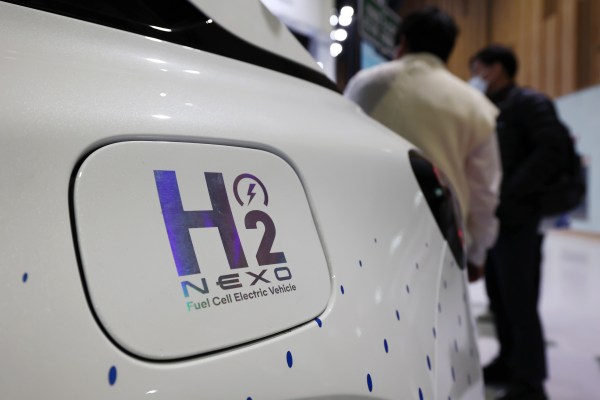When was the last time you watched an automotive company wax poetic about diesel engine controllers for Class 8 trucks? Or a tech conference keynote that touts the benefits of oxygen enrichment in blast furnaces to make steel? Or how to burn low-sulfur bunker fuel in oceangoing container ships?
Probably never.
So why did Hyundai devote half its CES keynote to a technology that’s best suited to long-haul trucking, steelmaking and maritime shipping?
The simple answer is greenwashing. It’s true that Hyundai has invested in hydrogen fuel cells for decades, but it has also been one of the more successful legacy automakers at navigating the electric transition. It’s odd that a company with so much momentum on its side would throw a hydrogen Hail Mary.
But maybe Hyundai’s EV rollout isn’t going as planned. Maybe the vehicles aren’t as profitable as the company would like. Maybe the company is having a hard time securing batteries. Or maybe it realizes that over 90% of its sales are still powered by fossil fuels and that by EV market share, the company is lagging. It might be the world’s third largest automaker overall, but it’s only in eighth place when it comes to battery EVs.
Enter hydrogen, a sector with a green aura about it, a useful distraction from more polluting realities. And since meaningful progress is still a decade or more away, it’s hard to hold the company to its claims.
Yet the claims made onstage won’t be particularly impactful, even if Hyundai follows through. The company says it will produce 3 million tons of hydrogen for its steel mills by 2030. That will give Hyundai Steel the capacity to produce 60,000 metric tons of green steel, or 0.0025% of the subsidiary’s 24 million metric ton capacity. Hyundai also said it will use some hydrogen in drayage trucks at ports and factories, an odd choice given that drayage is one of the easiest forms of trucking to electrify with batteries.
If that wasn’t enough, Hyundai also says that it will generate it from biogas and waste plastic. Because economically splitting water is too easy?
The biogas would come from digesters containing bacteria that chomp on food and other organic waste (and landfills, presumably). The methane in the resulting mélange then has to be separated from the other resulting gases, and the hydrogen cracked off the methane molecules. Each step requires energy and drives up cost.
Chang Hwan Kim, head of battery and fuel cell development at Hyundai, didn’t detail how the company would strip hydrogen from methane, but the most widely used method is steam reformation, an energy-intensive process that produces about 9 kg of CO2 for every kilogram of H2, according to Argonne National Lab. Hyundai might call the scheme clean, but no one would call it green.
The hydrogen-from-plastic technique, which Hyundai said it has patented, is similarly complex. In it, plastic is melted and gasified so the hydrogen can be cracked off the gaseous hydrocarbons. Each step would be energy intensive, and the whole endeavor will produce numerous and probably unpredictable pollutants. If the process has any hope of being cleaner than simply burning diesel, it will have to scrub or capture those pollutants, adding more complexity and cost.
Together, waste-to-hydrogen and plastic-to-hydrogen have to be two of the most convoluted, energy-intensive ways to make the gas. They’re practically the chemical equivalent of Rube Goldberg machines. Until we see life cycle analyses detailing the climate and environmental impacts of these hydrogen production methods, they’re little more than fodder for splashy YouTube titles.
But greenwashing isn’t the only reason Hyundai has launched a hydrogen PR blitz.
Behind closed doors, Hyundai is almost certainly worried about China’s stranglehold on the lithium-ion battery supply chain. Though South Korean companies are major manufacturers, Chinese companies dominate the markets for many components, including cobalt, graphite and lithium itself. Hyundai is dependent on Korean battery giants who themselves are at the mercy of Chinese suppliers. (Fuel cells also require expensive metals like platinum, but Hyundai has said it’s made progress reducing the amount required.)
On the other side of the equation, Korean automakers received an unwelcome surprise when the Inflation Reduction Act required certain levels of American content and assembly to qualify for EV rebates. Suddenly, Hyundai’s Ioniq 5 and Ioniq 6 became a lot more expensive relative to the competition.
Squeezed between China and the U.S. on EVs, Hyundai would no doubt like to free itself from geopolitics of critical minerals, but it knows it can’t go running back to fossil fuels, either. Jaehoon Chang, Hyundai’s CEO, said as much: “Hydrogen is fair. Hydrogen ensures global fairness through its high accessibility. It dissolves the divisions through the countries, resolves the energy imbalance caused by geographical disparities.” (I probably don’t have to point out that Chang’s plan for energy freedom relies heavily on one particular South Korean company’s fuel cells and electrolyzers.)
It’s not hard to see why Hyundai executives view the world through a geopolitical lens: For decades, the company has felt pressure from myriad stakeholders, like from OPEC, from countries anxious to tackle climate change, and now from the great powers struggling for control over the lithium-ion battery supply chain. For all I know, Hyundai execs might find hydrogen to be a useful delay tactic, stalling the decarbonization of their fleet, while also thinking that it could be their geopolitical trump card when the world finally phases out fossil fuels. To those execs, I say good luck. Geopolitical machinations don’t always work out as planned.

